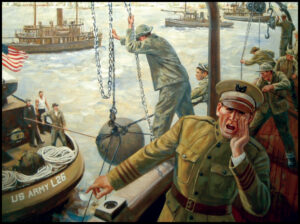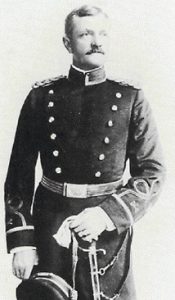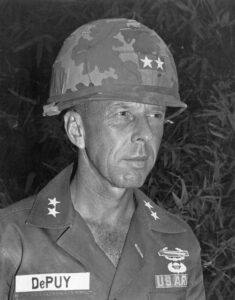Written By: Lieutenant Colonel Edward B. Cummings, USMC-Ret.
The motto that appears on the Great Seal of the United States, E Pluribus Unum (“Out of Many, One”), perfectly describes the invincible American defense line, established by Major General Andrew Jackson, which inflicted massive casualties on a powerful British force at the Battle of New Orleans on 8 January 1815. Fought on the fields of Chalmette Plantation six miles south of the city, the battle was a stunning American victory achieved by a mixed force of Regular Army troops, free blacks, Indians, and militia fighting side-by-side.
It ended an arduous month-long campaign full of other engagements, changes of command, confusion, boldness, timidity, tactical mistakes, timely arrivals of troops, and a huge amount of luck. The victory was made possible by an unlikely combination of oddly disparate forces, British logistic oversights and tactical caution, and superior American backwoods marksmanship.The battle marked the last land battle against the British in an unpopular war that had nearly succeeded in dividing the United States almost fifty years before the Civil War.

The victory at Chalmette was a dramatic reversal of a war record beginning in 1812 that had seen few American victories, most of these in naval battles. From the day the Battle of New Orleans was won until the news of Union victories at Vicksburg and Gettysburg in July 1863, each anniversary of that victory at Chalmette was a day of national celebration with fireworks and parades, much like the present observance of Independence Day on 4 July.
Like many of history’s pivotal moments, however, the campaign that ended in a forty-minute one-sided battle along the Rodriguez Canal at Chalmette was, in the Duke of Wellington’s famous words describing his victory at Waterloo over Napoleon later that same summer, “a damn close run thing.” Somehow, with personal diplomacy, entreaties, deals, and characteristic fiery persuasiveness, Andrew Jackson had managed to assemble over 5,000 men to oppose a strong British force of nearly 8,000 redcoats advancing upriver toward New Orleans. Publicly calling the invading British the “common enemy of mankind,”
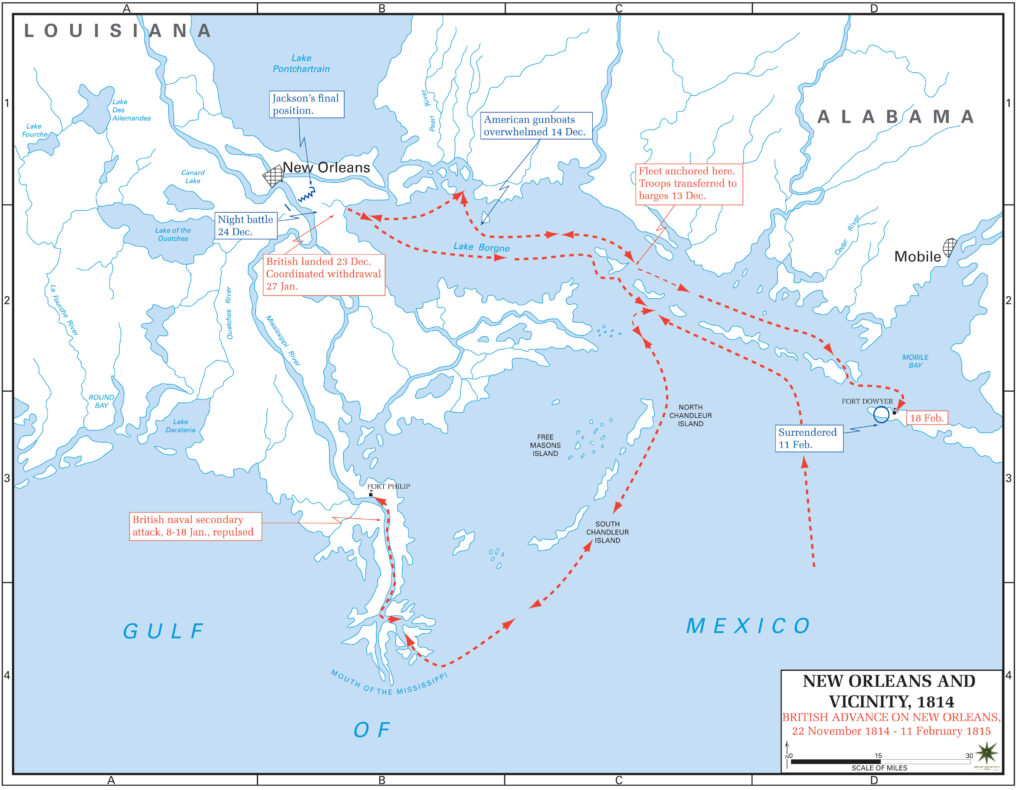
Jackson gathered an unlikely force of local New Orleans and Louisiana militiamen, many of whom were decendants of French settlers, Baratarian pirates under Jean Lafitte, Regular Army troops, U.S. Marines, militia from Tennessee, Kentucky, and Mississippi, and a company of New Orleans businessmen and “free men of color.” Representing merchant, pirate, and patriotic motivations—many of them self-serving and local rather than nationalistic—this force fought with incredible efficiency against a formidable British infantry attack, inflicting over 2,000 casualties in less than forty minutes. Neither side in the War of 1812 had a fully committed civilian populace or an adequate military force available for ambitious plans in the battle areas.
The fledgling United States had surprisingly declared war on England two days after the British Parliament had passed a resolution restricting the Royal Navy from impressing American sailors from merchant ships on the high seas. This was the Americans’ primary grievance against England and a declared cause for war. The New England states, much dependent on a prosperous trade with England with their fast, Yankee-built merchant ships, opposed the war from the outset.
This potential defection of New England from the war effort gave the British some hope that an operation, once again pushed southward from Canada down Lake Champlain, as a similar campaign during the American Revolution had intended, would split the United Sates politically and militarily. Heavily committed to a European military land and sea struggle to defeat Napoleon once and for all, England could not effectively concentrate a simultaneous effort of huge logistic complexity across the Atlantic at least until late 1814.
Napoleon’s abdication and exile to Elba in April 1814, before his triumphant and unexpected return for the “One Hundred Days” campaign that led to his final defeat at Waterloo, allowed England to transfer a significant number of veteran troops to America. An ambitious autumn campaign was planned to use these veteran forces and conclude the frustrating war with the United States and place England in a favorable bargaining position. One part of the plan called for a push down Lake Champlain and the Hudson River, with the aim of capturing New York City. A second attack, up the Chesapeake Bay and overland from the Patuxent River landing areas into Washington, would undermine and demoralize the American government.
A third powerful move, to capture New Orleans or Mobile, would establish stranglehold control of all Mississippi River commerce. These three endeavors, except for the burning of most of the government buildings in Washington, an act that mightily inflamed American resistance, were frustrated by significant American military victories.
The American victory near New Orleans on 8 January 1815 is often thought of as a unique event that occurred when the opposing forces suddenly met and decided everything on one bloody morning. In reality, it was the culmination of a strenuous month-long struggle by powerful British naval and land forces to advance upriver through forbidding swamps and gain control of the city. During that same month, American forces contended with many problems of their own. Fog, cold rain, parochial self-interests, command and control friction, the assignment of leaders, and logistics problems seriously hampered the best intentions of all.
In this campaign, important preliminary engagements included a battle between gunboats on Lake Borgne and a daring night attack by Jackson on 23 December at Villeré Plantation that stalled the fast, and as yet unopposed, British advance toward the city. The night attack on 23 December was a confused melee that cost the British 277 casualties (46 killed, 167 wounded, 64 missing) and the Americans 214 (24 killed, 115 wounded, 74 missing). Often thought of as a minor clash, this night battle was an important and bloody event, fought man to man and squad to squad. It decisively stopped the British advance and contributed significantly to the later victory on the Chalmette field sixteen days later.
This night engagement and setback at Villeré plantation instilled a new caution in the British officers and gave the Americans additional time to fortify an already strong position on the river at Chalmette. Taking some new heart from their 27 December sinking of the schooner USS Carolina, a ship which had poured shot and shell into their encampment during the 23 December battle, the British launched an infantry attack against the stubborn and ever-strengthening American line on 28 December.
When this attack failed due to heavy American counter-battery fire and long-range marksmanship, the new British commander, Major General Sir Edward Pakenham, who had just assumed overall command on Christmas day, recalled the troops and later termed the attempt as a “reconnaissance in force.” It was never intended to be anything but a probing attack of the American line, but its failure gave Pakenham a new respect for the Americans who opposed him.
The decision was then made to assault the American line on 1 January with all the artillery that could be brought to bear. Pakenham also made plans to attack the main American line with infantry in darkness, when American long-range rifle marksmanship would be less likely to take such a fearsome toll before the disciplined British troops went over the ramparts with their bayonets. The artillery battle on 1 January saw fifteen American guns dueling against twenty-four British guns. American accuracy and rate of fire soon put most of the British guns out of action or forced them to be withdrawn.
One British veteran recalled that “we thought gun emplacements of sugar barrels would protect us, but the American shot tore through them like butter and killed most of our crews outright.” An important force in support of the American line was also the so-called “Marine Battery” of three land-mounted guns recovered from the sunken schooner USS Carolina and emplaced directly across the river from the main American line. This battery projected accurate enfilade fire the British would have to eliminate to prevent complete disruption of attack formations, even before they came into American rifle range. Many of the British guns were naval weapons, short range carronades firing at a flat trajectory more suited to sea-going broadsides than use as field artillery.
Much of the British artillery fire crashed harmlessly into the solid high rampart of the American line. Heavy mortars, which Pakenham had urgently requested and which would have lofted shells behind and on top of the American position, were not available. They eventually did arrive, but three days after the 8 January battle had been fought and lost. After the ineffective artillery battle on 1 January, Pakenham realized he had only two choices left available to him.
He could withdraw his forces, a move that would invite American attack at a time and place of their choosing and demoralize his troops, or make a maximum effort against the American line. Trusting as always in the steady discipline and the leadership of his veteran officers, he decided to attack. Between the British “reconnaissance in force” attack on 28 December and the main infantry attack on 8 January, Jackson had greatly strengthened the American position.
As mentioned earlier, guns from the sunken schooner USS Carolina were retrieved and placed into the Marine Battery on the west bank of the Mississippi River opposite the Chalmette line. Other guns, including a heavy 32-pounder manned by the Louisiana Free Men of Color in the center of the line, were put into well-spaced batteries along the rampart. Eventually, the American gun total reached twelve along the rampart and three in the Marine Battery, for a total of fifteen well-manned and well-provisioned cannons. Brigadier General John Adair arrived at Chalmette on 4 January with 2,500 hard-marching, tough Kentuckians. The Kentucky militiamen added significant last-minute weight to the growing ranks of skilled riflemen in position along the Chalmette rampart.
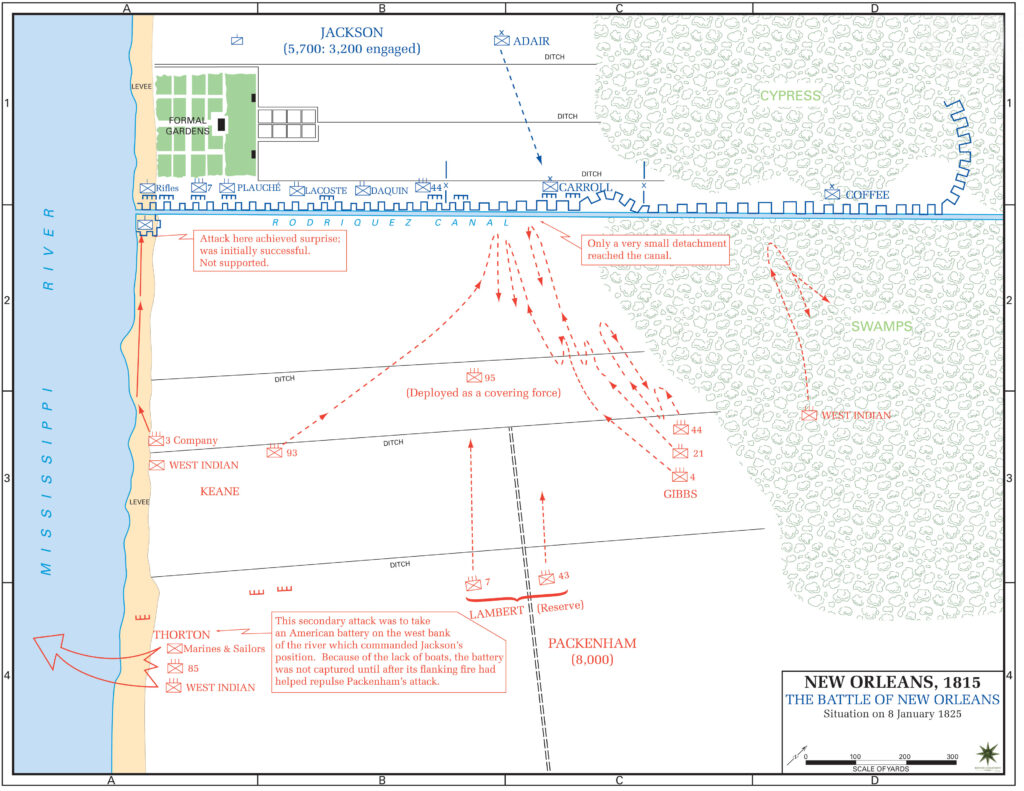
Jean Lafitte’s arrival with his Baratarian “privateers” further strengthened the line, as he also brought with him a significant supply of fine dry black powder and 7,000 badly needed new flints for muskets and rifles. Jackson was gracious enough to thank Lafitte and the men he had often called “hellish banditti” and “pirates” and put them immediately into the defensive line at Chalmette. The rampart itself was extended fully into the cypress swamp that bordered the Chalmette fields, anchoring the previously vulnerable left side of the American line.
The right side of the American line was firmly anchored on the steep river levee. Just inside this levee ran the river road to the city, the only possible route for the British forces to march toward New Orleans, once they had broken the American line. During the failed infantry attack on 28 December, the British had noted the unfinished line on the American left flank and a possible way around it that would keep flanking forces out of the swamp and on a narrow strip of dry ground.

This area, as well as the levee road, were two possible points where an assault could break the American line. This finding drove the British to adopt a plan to commit its main attack force, led by Major General Samuel Gibbs, to the American left. A simultaneous but smaller attack force would be led by Colonel Robert Rennie up the levee road. Either attack, if successful, could be reinforced by cross-over troops or commitment of a three-regiment reserve force, led by Major General John Lambert, held in stalwart readiness and relative safety 400 yards from the American line. The American center, given its strength by virtue of intense converging fire and the formidable 32-pounder cannon, was not in the British plan of attack, and if at all possible, was an area to be strenuously avoided.
Early morning fog and the failure to receive the rocket signal from Colonel William Thornton’s attacking force across the river that the Marine Battery had been overcome delayed the pre-dawn planned assault on the Chalmette line for a full two hours. Thornton’s force of 1,200 British troops had failed to find enough boats for all of his men to cross the river together, and the unexpectedly swift current had carried most of them a full mile further downstream from their intended landing site.
Pakenham decided to proceed with the main assault even without the expected signal from the west bank. This decision fully exposed his troops to continuous artillery fire as they made their approach march toward the rampart, but it was a decision he believed he must make because any additional delay under the enfilade fire would guarantee failure of the whole effort.
As the fog lifted on the morning of 8 January, the breathtaking sight of ten massed regiments of red-coated troops greeted the anxious American troops. As soon as the improving visibility permitted, Major General John Coffee, on the American left, gave his Tennesseans an order to fire at will and at maximum range with their small caliber Kentucky long rifles. A surviving British veteran wrote years later that “these damned Yankee riflemen can pick a squirrel’s eye out as far as they can see it.”
The Tennessee riflemen began taking a fearsome toll against the mounted British officers of Major General Gibbs’ column at killing ranges approaching 300 yards. Color bearers, noncommissioned officers, and those on horseback began to fall at ranges they had believed themselves safe as they made final preparations to go forward. It was the usual British formula for victory that had worked so often for them in European conflicts.
They would advance stoically toward the enemy until within the short fifty-yard range of their “Brown Bess” muskets, discharge largely unaimed volley fire by ranks, and then charge with the bayonet. The thought of being run through with cold steel was usually enough to panic any foe. There was no reason to believe this attack plan would not succeed at Chalmette—but only if the distance to the American line could be closed quickly. Incredibly, however, the numerous fascines to fill the rampart fronting ditch and the scaling ladders to climb the rampart, were left behind in the initial assault. The formations were halted within rifle range while the sappers and engineers went back to the rear, retrieved the missing items, and brought them forward.
This delay cost the British additional heavy losses they could ill afford. Seeing the tremendous effect of well-aimed American fire on the British right flank, Major General John Keane, commanding the column on the British left, ordered the gallant 93d Highlanders regiment to cross diagonally across the American front to bolster Gibbs’ staggering assault. From their position near the river, the 93d Highlanders stepped out in perfect formation and marched across a raging American line.
Out of 900 men who started the morning with the 93d Highlanders, only 130 survived the day. In an effort to rally the troops on Gibbs’ front, Pakenham came forward, was wounded in the arm, had a horse shot from under him, and finally was mortally wounded. As he was taken to the rear, his dying order to Lambert, commanding the reserves, was to commit his force and continue the attack.

Lambert, fully aware of the mounting odds stacked against the British, called off the attack and ordered a retreat. In less than forty minutes, the fighting was over, and as the smoke cleared from the battlefield, a scene of awesome devastation revealed itself. Across a front of 300 yards in width and 400 yards in depth, the ground was covered with over 2,000 dead or wounded British soldiers, as well as many that had simply fallen to the ground to escape the tempest of lead.
When the reality of defeat and retreat was clear to these surviving men, many raised their arms in surrender and came forward toward the American lines. American casualties were minimal—eight killed and thirteen wounded. The British plan for battle on 8 January was to assault the American positions on both sides of the river simultaneously. Due to river crossing difficulties, the 1,200 man force under Colonel Thornton was unable to attack the American position on the west bank until two hours after the main attack on the Chalmette field.
This attack delay allowed the Marine Battery to remain fully functional, and its three-gun battery poured enfilade fire with great effect on the British formations across the river as they attacked up the levee road. By the time the British force on the west bank captured the guns, the main effort had already failed. The success of the British troops on the west bank could not be supported, and they were consequently withdrawn with the rest of the defeated British force.
The Americans were victorious due to Major General Jackson’s driving leadership, his ability to unify an unlikely coalition of fighters, the timely arrival of troops, and his good fortune to have Jean Lafitte offer his supply of fine dry gun powder and sharp new flints. Jackson’s decision to attack the British on the night of 23 December at Villeré Plantation led to a battle historically understated in importance to the overall campaign.
This unexpected night battle knocked the British on their heels and put them immediately into a cautious and defensive frame of mind. Jackson’s effective use of long-range naval 6-pounder cannons salvaged from the sunken schooner USS Carolina added to his decided artillery advantage over the British.
To dispel one of the most persistent myths about the Battle of New Orleans, it must be said that it did not occur after the War of 1812 had ended. The terms of peace proposed in the Treaty of Ghent, reached by negotiations between American and British emissaries in Belgium on Christmas Eve 1814, needed to be ratified by both governments prior to a formal end to hostilities. The proposed treaty arrived in New York on 11 February and was rushed by express coach to Washington. It was formally ratified in a ceremony on 17 February.
There was urgency in this legislative protocol because the British force, although beaten at Chalmette, had withdrawn to Mobile and was still a powerful threat to that area. The ratification ceremony officially ending the war took place a full six weeks after the battle.
Neither leader of the engaged forces at Chalmette knew of the ongoing developments that would conclude the war, and it is doubtful that sea communications between Europe and America could have been any faster in the winter of 1814-15. Jackson’s victory at New Orleans gave the United States a renewed national pride, restored confidence in its military might, and justified expansionist dreams that would later bring us to new military adventures in Texas and Mexico.
It gave “Old Hickory” a powerful populist edge to become the seventh President of the United States, and the first to be elected from a region west of the Appalachian Mountains. The new “American West,” as the region west of the Appalachians and east of the Mississippi River was then known, had supplied the charismatic leader and most of the troops for this battle. Our nation’s quest to follow its perceived “Manifest Destiny” doctrine began at New Orleans on 8 January 1815, with an astonishing victory made possible only with an unlikely “marriage of convenience” unique in American military history.
